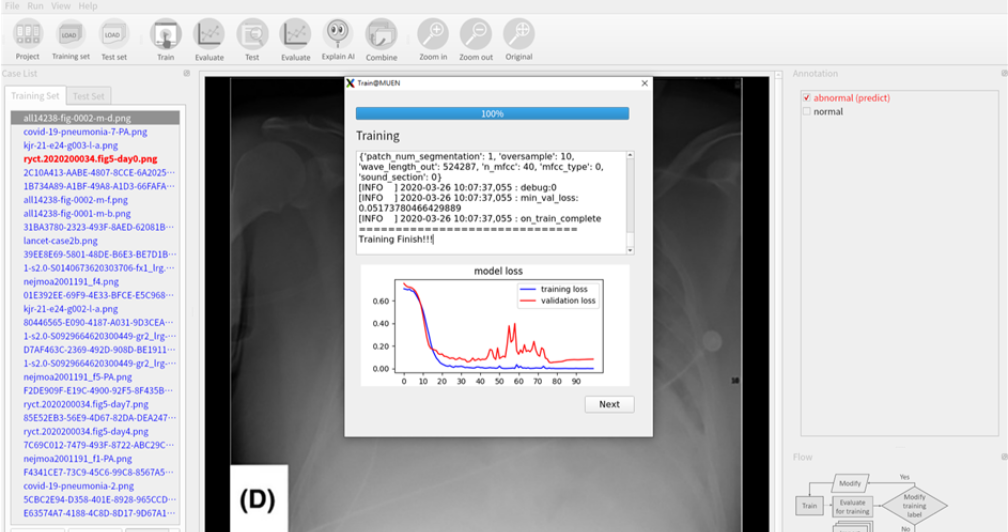COVID-19
The first case appeared in Wuhan in December 2019. The new coronavirus belongs to the Coronaviridae family and is a single-stranded RNA positive-strand virus. The virus is highly infectious, infects via droplets and contact, and mainly infects the lower respiratory tract. It has an incubation period of 1-14 days. The symptoms are not necessarily obvious. Patients may experience fever, dry cough, tiredness, mouth and nose sensory disorders. It is known that viral spikes mainly contact ACE2 on mucosal cells for cell membrane fusion, thereby entering a large number of viral RNA and protein shells in cells, assembling them by high-profile bodies and sending them out of the cell for the next wave of infection. COVID-19 is currently pandemic and is spreading throughout the world. Therefore, the detection of COVID-19 is an urgent issue.
Dataset information
Data Information
Image type: Chest X-ray
Image size: 298 x 294 – 4248 x 3480



Fig.1
(Up Left) Healthy chest X-ray from Stanford dataset, (Up Right) COVID-19 patient chest X-ray from Github: ieee8023/covid-chest x-ray-dataset
(Down Left) Disease chest X-ray from Stanford dataset, (Down right) Tuberculosis chest X-ray from Tuberculosis dataset
Data Training and Testing Information

To apply MAIA in clinic detection, it is essential to rely on professional medical practitioners to operate MAIA and thereby perform diagnosis and treatment. We look forward to fighting off COVID-19 together.
The first case appeared in Wuhan in December 2019. The new coronavirus belongs to the Coronaviridae family and is a single-stranded RNA positive-strand virus. The virus is highly infectious, infects via droplets and contact, and mainly infects the lower respiratory tract. It has an incubation period of 1-14 days. The symptoms are not necessarily obvious. Patients may experience fever, dry cough, tiredness, mouth and nose sensory disorders. It is known that viral spikes mainly contact ACE2 on mucosal cells for cell membrane fusion, thereby entering a large number of viral RNA and protein shells in cells, assembling them by high-profile bodies and sending them out of the cell for the next wave of infection. COVID-19 is currently pandemic and is spreading throughout the world. Therefore, the detection of COVID-19 is an urgent issue.
Dataset information
| Source | Label |
| Stanford ML Group CheXpert Dataset https://stanfordmlgroup.github.io/competitions/chexpert/ |
Healthy |
| Joseph Paul Cohen, COVID-19 image data collection https://github.com/ieee8023/covid-chestxray-dataset |
COVID-19 (+) |
| 1. Stanford ML Group CheXpert Dataset https://stanfordmlgroup.github.io/competitions/chexpert/ 2. Chest X-Rays tuberculosis from India https://www.kaggle.com/raddar/chest-xrays-tuberculosis-from-india |
COVID-19 (-) |
Data Information
Image type: Chest X-ray
Image size: 298 x 294 – 4248 x 3480



Fig.1
(Up Left) Healthy chest X-ray from Stanford dataset, (Up Right) COVID-19 patient chest X-ray from Github: ieee8023/covid-chest x-ray-dataset
(Down Left) Disease chest X-ray from Stanford dataset, (Down right) Tuberculosis chest X-ray from Tuberculosis dataset
Data Training and Testing Information
| Dataset / Quantity | Training Set Image/Patient |
Testing Set Image/Patient |
| CheXpert Healthy | 4455/4000 | 1109/1000 |
| CheXpert Disease Tuberculosis |
11260/4000 50/50 |
2774/1000 25/25 |
| COVID-19 (+) | 50/35 | 22/14 |
- The model validation set is automatically and randomly split by MAIA in the training stage.
- COVID-19 Training and Testing data are split by patient ID.
Hardware Information
CPU: i7-8750H
RAM: 32GB
GPU: RTX-8000*2 96GB
Software: MAIA
Deep learning is one of the fields of machine learning. Muen team has created a software-Medical AI Aggregator(MAIA) that has the ability to learn the relation between data and labels, and produce prediction models based on it's learning. Apart from traditional machine learning skills, Muen's technology achieves higher accuracy and versatility. Hundreds and thousands of images can be automatically processed in a short period of time to obtain the prediction model.

Fig2. Medical AI Aggregator Interface
Evaluation
| Stage/ Metrics | AUC | Precision | Recall | Specificity | F1 Score | Accuracy |
| Testing | 0.9500 | 0.8249 | 0.8606 | 0.8926 | 0.8416 | 0.8672 |
Fig3.
In model Evaluation, MAIA achieved 86.7% accuracy, 82.4%, precision, 89.3%recall, 89.3% specificity, 84.2% f1_score.
**Healthy cases from CheXpert Dataset, Disease cases from CheXpert Dataset and Tuberculosis dataset, COVID-19 cases from github: ieee8023/covid-chestxray-datase
Summary
MAIA Software classified Chest X-ray between healthy, different diseases and COVID-19 data by utilizing only two RTX 8000 GPU. MAIA not only runs with low memory consumption hardware but also output a robust model by a small amount of COVID-19 dataset.In model Evaluation, MAIA achieved 86.7% accuracy, 82.4%, precision, 89.3%recall, 89.3% specificity, 84.2% f1_score.
**Healthy cases from CheXpert Dataset, Disease cases from CheXpert Dataset and Tuberculosis dataset, COVID-19 cases from github: ieee8023/covid-chestxray-datase
Summary
To apply MAIA in clinic detection, it is essential to rely on professional medical practitioners to operate MAIA and thereby perform diagnosis and treatment. We look forward to fighting off COVID-19 together.

